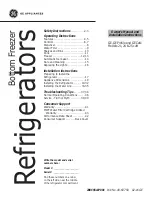
21
TROUBLE-
SHOOTING
Try the solutions suggested here first in order to
avoid the cost of an unnecessary service call.
Your refrigerator will not operate
■
Is the power supply cord unplugged
?
Firmly plug the cord into a live outlet with proper
voltage.
■
Has a household fuse or circuit breaker tripped?
Replace the fuse or reset the circuit.
■
Is the Refrigerator Control turned to the “OFF”
position?
Refer to the “Setting the Controls” section.
■
Is the refrigerator defrosting?
Recheck to see if the refrigerator is operating in 30
minutes. Your refrigerator will regularly run an
automatic defrost cycle.
The lights do not work
■
Is the power supply cord unplugged?
Firmly plug the cord into a live outlet with proper
voltage.
■
Is a light bulb loose in the socket?
Turn the refrigerator control to OFF. Disconnect the
refrigerator from the electrical supply. Gently remove
the bulb and reinsert. Then reconnect the refrigerator to
the electrical supply and reset the refrigerator control.
■
Has a light bulb burned out?
Replace with an appliance bulb of the same wattage,
size, and shape. See the “Changing the Light Bulbs”
section.
There is water in the defrost drain pan
■
Is the refrigerator defrosting?
The water will evaporate. It is normal for water to drip
into the defrost pan.
■
Is it more humid than normal?
Expect that the water in the defrost pan will take longer
to evaporate. This is normal when it is hot or humid.
The motor seems to run too much
■
Is the room temperature hotter than normal?
Expect the motor to run longer under warm conditions.
At normal room temperatures, expect your motor to run
about 40% to 80% of the time. Under warmer
conditions, expect it to run even more of the time.
■
Has a large amount of food just been added to the
refrigerator?
Adding a large amount of food warms the refrigerator. It
is normal for the motor to run longer in order to cool the
refrigerator back down. See the “Food Storage Guide”
section.
■
■
■
■
Are the doors opened often?
Expect the motor to run longer when this occurs. In
order to conserve energy, try to get everything you
need out of the refrigerator at once, keep food
organized so it is easy to find, and close the door as
soon as the food is removed.
■
■
■
■
Is the control set correctly for the surrounding
conditions?
Refer to the “Setting the Controls” section.
■
■
■
■
Are the doors closed completely?
Push the doors firmly shut. If they will not shut all the
way, see “The doors will not close completely” later in
this section.
■
■
■
■
Are the condenser coils dirty?
This prevents air transfer and makes the motor work
harder. Clean the condenser coils. Refer to the
“Cleaning Your Refrigerator” section.
NOTE:
Your new refrigerator will run longer than your old
one due to its high efficiency motor.
















































